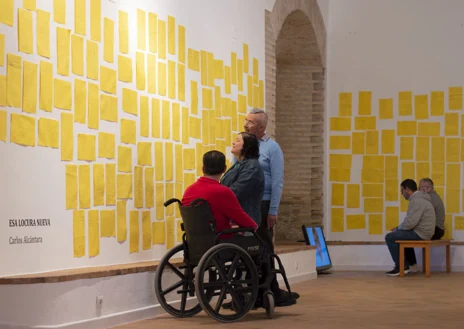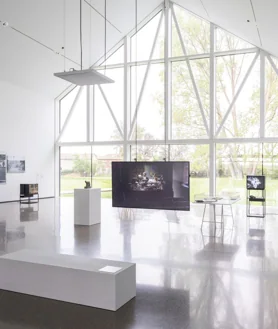On October 11, the festival was inaugurated at Pompidou-Málaga ‘Hors pistes’, Dedicated in this VIII edition to the ‘new ruralities’. It reviews the work of current artists, such as Juan del Junco or Asunción Molinos Gordo, who take the imaginary of the field and actively work in this environment, making it transcendent. The projects they present are excellent allegations of rural life and knowledge, despised and in danger of disappearance.
In itself, these artistic exercises around the rural world suppose a contemporary social symptom, an issue that occupies and worries, that even gains space in the programming of urban exhibition centers. In fact, this festival is scheduled parallel to the semi -permanent exhibition ‘Place-NESS. Inhabit a place ‘, which occupies the center, questioning, among other reasons, the acendrated binary confrontation between city and countryside, advocating interdependence.
However, these lines do not seek only to see how artistic institutions (urban) serve the rural; They accommodate current proposals on the world of the field from different perspectives that value their landscape, environmental and patrimonial wealth; as well as they go into Thick problems of a Spain as empty as unattended. These lines aspire to place the rural, that imprecise and overflowing space, as an undeniable artistic field, certainly crucial, absolutely emerging, thanks to the relevance of their proposals, the rigorous of their methodologies and the creative and committed of their solutions.
Thus, one day after the inauguration of ‘New Ruralities’, in the mountains of Cous Luck of celebration of that natural framework that, in a walk and coexistence in the place, combined tradition, popular knowledge and self -management formulas of the communal mountain and natural resources. All this with an inalienable and valuable sustainable and inclusive character.
A clear cultural effervescence
A country as extensive and varied as Spain has numerous cultural initiatives in rural areas, so that the one who writes feels that some examples that make visible the cultural effervescence of our rural can be transferred here.
A cultural emergency that responds to the mood of defense of what it represents – we could speak of pride – and to postulate governance and management models as authentic responses to the different crises that affect the peoples and inside the most uninhabited in the country. Not a few times, these actions play ldouble function of being a call for attention – I don’t know whether even – and a demonstration of the creative, organizational and relevance capacity of the models of that area to which it is so neglected. They have a clear political sense, in the best and broader sense of the term. In them they beat an eagerness for transformation, a certain demand for social justice and the conviction of proposing formulas of sustainability and inclusiveness through contemporary art.
This movement is accompanied by an important writing flow on the phenomenon of abandonment and resilience of the rural world. The Ministry of Culture put ‘culture and citizenship’ operation, a platform that gives technical support and theoretical coverage to ruralities. In that area, valuable contributions have been published, such as’ thinking and doing in rural areas. Cultural practices in context ‘(2020), coordinated by Benito Burgos; or the report ‘Keys and impacts of culture in rural areas. The value of the intangible ‘(2024).


From top to bottom, Mateo Chica (left) in the active listening process of the neighbors of Genalguacil for their project for the 2024 meetings; IV Artistic Residences of La Puebla de Cazalla. Carlos Alcántara project; and assembly of ‘The Animal in Spain’, in the Celesales Foundation
We cannot ignore the epiphanic ’empty Spain: trip through a country that never was’ (2016), by Sergio del Molino, which, beyond putting name to the phenomenon, made awareness and generate debate. We must also name ‘Land of Women. An intimate and familiar look at the rural world ‘(2019), from María Sánchez, Criticism that is accompanied by an injection of pride and faith in the potentialities of the rural. Cinema and music have had important looks to the rural in recent years, such as ‘Alcarràs’ (2022), by Carla Simón, or the figures of Rodrigo Cuevas and Rozalén.
In this map we find referential projects, such as Genalguacil Pueblo Museo (Málaga) and the Cerezales Foundation Antonino and Cinia (Cerezales del Condado, León). They are also cases in which artistic production is ruled with knowledge equivalent to the production of knowledge. In 2024, 30 years of the birth of Genalguacil Pueblo Museo, an example of the fight against depopulation through contemporary art.
This tireless work, in which artists are put in contact with the community and the territory, generating an overwhelming heritage, is accompanied by the recent opening of the International Rural Innovation Laboratory, in which development methodologies are tested. Exemplary is also the Cerezales Foundation, aimed at proposing new knowledge paradigms and relationship with nature.
Currently, the magnificent ‘Villages of Colonization’ program, which could be seen in the ICO Museum. Previously, he hosted the dazzling and revealing project ‘Lo Animal in Spain, 1920-1964’, commissioned by Lluís Alenxandre Casanovas, that illustrated the changing consideration and relationship of humans and animals.
, by Juan del Junco](https://s3.abcstatics.com/abc/www/multimedia/cultura/2024/11/07/junco-U36730871774gmI-760x427@diario_abc.jpg)
The flock [El lenguaje](2013), by Juan del Junco
Of the infinite payroll of museums of territory and artistic projects in and about the rural (Mutur Beltz In the Carranza Valley, Collegium in Arévalo,Black Dice Center In Villanueva de los Infantes, Montenmedio Foundation in Vejer de la Frontera, River affectivity Around the Ebro axis territories …), we can end with a throbbing one: the Art Brut Conference and the Artistic residences of La Puebla de Cazalla (Seville), which inaugurated their VII edition a few weeks ago.
Directed by Alegría and Piñero, the users of the town’s occupational center create with renowned artists for a month, generating, in a shared learning process, works that make up the annual exhibition.
#ruralities #people #save #town

